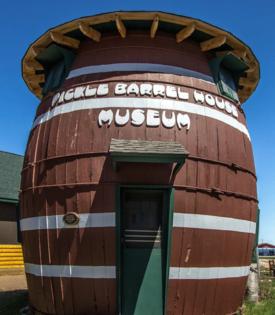Seen All the Big Museums? Try These!
Each year, more than 5 million people visit the Metropolitan Museum of Art in New York City. The American Museum of Natural History, located nearby, attracts some 4 million callers annually. Other museums around the country appeal to far fewer folks, but those who discover them find much that educates and entertains.
We're talking collections focused on potatoes and mustard, locks and alleged landings of unidentified flying objects along with other offbeat galleries. Some may be located near where you live, while others might tempt you to make a trip to see them.
The Idaho Potato Museum showcases that state's famous spuds. Exhibits include the world's largest potato chip, a 14-by-15-inch crisp; how fries were introduced to the White House by Thomas Jefferson; and 1,600-year-old vessels that are believed to be the first containers used specifically for potato storage.
More than 5,600 jars of mustard from over 60 countries greet callers at the National Mustard Museum in Middleton, Wisconsin. Other displays include mustard memorabilia and exhibits depicting the use of the condiment throughout history. Those who wish to take home a souvenir can choose from a long list of recipes, a mustard jar opener and clothing ranging from a "Mustard Happens" apron to a "Poupon U" T-shirt.
A unique bolt that sprays tear gas is among items seen at the Lock Museum of America in Terryville, Connecticut. It is home to the largest collection of locks, keys, handcuffs and ornate door hardware anywhere.
The building occupies the site of the Eagle Lock Co., which during its lifespan (1833-1975) was the largest trunk- and cabinet-lock manufacturer in operation. The establishment claims to provide an introduction to "the genius of lock makers who over the centuries have constantly tried to stay one step ahead of the bad guys."
In 1947 a rancher in New Mexico discovered metal debris near a trench that spanned hundreds of feet. That became the basis for conspiracy theories alleging that the fragments were from an extraterrestrial spacecraft that had crashed. In fact, it belonged to a military balloon that was designed to detect nuclear tests by the Soviet Union. That incident is recalled at the International UFO Museum and Research Center in Roswell. It preserves materials and information connected to the event and other unexplained phenomena related to unidentified flying objects.
Those who happen upon an unusual structure in Grand Marais, Michigan, also might imagine that they have been transported to a never-never land. It's a 16-foot-high building comprised of two oversized barrels, with windows shaped like pickle jar lids. That quirky wooden wonder was erected in 1926 in the shape of a pickle barrel. The larger cask of the Pickle Barrel House serves as the living area and bedroom, while the smaller adjacent drum contains the kitchen. In keeping with its history, the furnishings echo 1920s decor. In keeping with its architectural theme, exhibits at the Pickle Barrel House Museum trace the history of the building, showcase the story of pickling and include vintage photographs and pickle-themed memorabilia.
An equally quirky experience awaits guests at the Museum of Bad Art in Boston, whose motto is "Art too bad to be ignored." It was founded in 1933 after an antique dealer showed an appallingly bad painting he had recovered from the trash to friends, who suggested that he start a collection.
Surprisingly, the museum sets rigorous standards for works it will accept. Its tongue-in-cheek explanation is that "Nine out of 10 pieces don't get in because they're not bad enough. What an artist considers to be bad doesn't always meet our low standards."
----
WHEN YOU GO
idahopotatomuseum.com
mustardmuseum.org
lockmuseumofamerica.org
roswellufomuseum.com
michigan.org/attractions
museumofbadart.org
========
Victor Block is a freelance writer. To read features by other Creators Syndicate writers and cartoonists, visit the Creators Syndicate website at www.creators.com.
Copyright 2025 Creators Syndicate, Inc.

































Comments